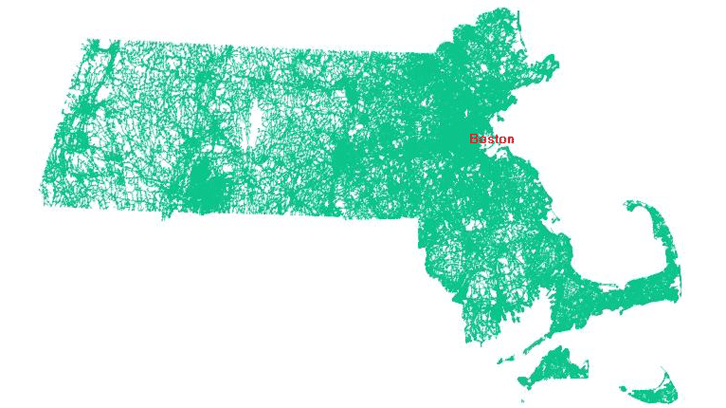The importance of distance in population density distributions

Choices for residential location depend mostly on individual preferences and neighborhood characteristics, including features that embed a temporal connotation as, for instance, territorial reputation or ethnic composition. All this information contributes to shaping expectations and beliefs about location choices.
In general, individuals most often show a clear propensity for settling close to those places that are focal points of their economic and/or leisure activities. With this perspective, transportation facilities are an important resource in order to guarantee mobility and to favor the homogeneous spreading of the spatial location of individuals.
In this study, we evaluate the importance of accessibility to Boston in shaping population density distribution in Massachusetts over time once Boston has been identified as the main point of interest for the state (the so-called central business district, or CBD).
In order to address this issue, we collect data from 1880 to the present day. By exploiting Bayesian estimation techniques, we are able to assess that Boston’s attractiveness increased up until 1920; then it declined until it experienced a resurgence in the 1980s. The first rise of Boston’s attractiveness is associated with the technological advances and urbanization of economic activity, while its decline was due to the reduction in manufacturing activity and the growth of automobiles and, thereby, a private means of transportation. The current appeal of Massachusetts’ capital city is associated with its relative abundance of high-skilled workers, which attracts highly specialized economic activities.
Our interest is in detecting changes in the importance of the determinants for accessibility to Boston and their role in shaping citizens’ location preferences. One might expect that improvements in the efficiency of the transportation network would yield a reduction in the impact of geographic distance from Boston as the main determinant in location choices. Instead, we picture a bell-shaped dynamic by taking into consideration Boston’s distance and ethnic neighborhood population composition as the two principal driving forces. In particular, we identify a progressive segregation process in population distribution taking place from 1970 onward. The economic literature relates this tendency for segregation to the real estate market: properties in Boston (and surrounding areas) were extremely expensive, and for decades, not all citizens had access to credit markets. This difficulty, in effect, favored the creation of ethnic ghettos that reinforced the propensity of white citizens to settle in individual dwellings far from Boston.
In light of this evidence, our study concludes that regional planning authorities may have an interest in considering strategies designed to boost accessibility to CBD and reduce overcrowding in selected areas. Improving the quality of the public transportation infrastructure cannot always lead to higher residential mobility if citizens’ location choices are strongly driven by ethnic preferences.
Universitat Autònoma de Barcelona
References
Ilenia Epifani & Rosella Nicolini (2017) Modelling population density over time: how spatial distance matters, Regional Studies, 51:4, 602-615, DOI:10.1080/00343404.2015.1110237


